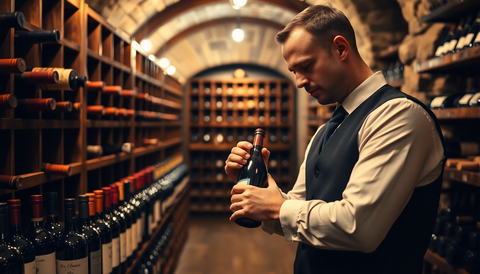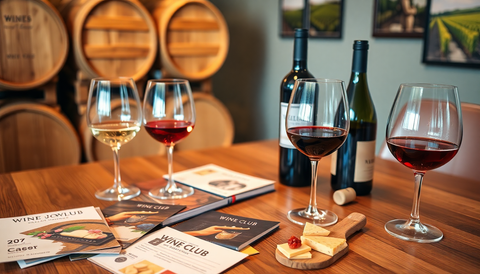As the sun sets over the rolling vineyards of McLaren Vale, the team at McLaren Vale Cellars knows that the true magic of wine lies not just in the bottle, but in how it is cared for and preserved. In a region renowned for its world-class vintages, the art of wine storage has become a crucial consideration for wine enthusiasts and collectors alike.
The Importance of Proper Wine Storage
Wine, like any fine work of art, is a delicate and complex creation that requires careful attention to thrive. Whether you're a seasoned collector or a passionate wine lover, understanding the principles of proper wine storage is essential to ensuring your prized bottles reach their full potential.
Improper storage can lead to a host of issues, from premature aging and oxidation to the development of off-flavors and aromas. By mastering the art of wine storage, you can unlock the true essence of your favorite vintages, allowing them to evolve and mature gracefully over time.
Navigating the Challenges of Wine Storage Without a Cellar
For many wine enthusiasts, the dream of a dedicated wine cellar remains just that – a dream. The reality is that not everyone has the luxury of a temperature-controlled, humidity-regulated underground sanctuary to house their collection. However, this doesn't mean you have to compromise on the quality and longevity of your wines.
In this comprehensive guide, we'll explore a range of practical and innovative solutions for storing wine without a traditional cellar, empowering you to become a master of wine preservation, even in the most space-constrained environments.
Understanding the Ideal Wine Storage Conditions
Before we dive into the specifics of wine storage solutions, it's essential to understand the key factors that contribute to the optimal preservation of your wines.
Temperature
Temperature is perhaps the most critical element in wine storage. Ideally, wines should be stored at a consistent temperature between 55°F and 65°F (13°C and 18°C). Fluctuations in temperature can cause the wine to expand and contract, leading to premature aging and the potential for leakage or cork damage.
Humidity
Maintaining the proper humidity level is also crucial for wine storage. The ideal range is between 60% and 70% relative humidity. This helps to prevent the cork from drying out and the wine from evaporating, ensuring a tight seal and preventing oxidation.
Light Exposure
Exposure to direct sunlight or bright artificial light can be detrimental to wine, causing it to age prematurely and develop undesirable flavors and aromas. Wines should be stored in a dark or dimly lit environment to protect them from harmful UV rays.
Vibration
Excessive vibration can disrupt the delicate balance of a wine, causing the sediment to become unsettled and the flavors to become muddled. Wines should be stored in a location free from significant vibrations, such as those caused by heavy machinery or high-traffic areas.
Innovative Wine Storage Solutions for Small Spaces
Now that we've established the key principles of proper wine storage, let's explore some practical solutions for those without a dedicated wine cellar.
Temperature-Controlled Wine Fridges
One of the most popular and effective solutions for wine storage in small spaces is the use of a temperature-controlled wine fridge. These specialized appliances are designed to maintain the ideal temperature and humidity levels for wine preservation, often with additional features like UV-resistant glass doors and vibration-dampening technology.
Wine fridges come in a variety of sizes, from compact countertop models to larger, free-standing units, making them a versatile option for homes and apartments of all sizes. They provide a controlled environment that mimics the conditions of a traditional wine cellar, ensuring your wines are stored in optimal conditions.
Insulated Wine Cabinets
For those seeking a more discreet and space-saving solution, insulated wine cabinets offer an excellent alternative. These cabinets are designed to maintain the necessary temperature and humidity levels, while blending seamlessly into your home's decor.
Insulated wine cabinets can be built-in or freestanding, and often feature features like dual-zone temperature control, UV-resistant glass doors, and adjustable shelving to accommodate a range of bottle sizes. They provide a compact and stylish way to store your wine collection, without sacrificing the essential elements of proper preservation.
Passive Cooling Systems
If you're looking for a more budget-friendly option, passive cooling systems can be an effective way to store wine without a dedicated cellar. These systems, which may include wine coolers or insulated wine racks, utilize the natural temperature fluctuations of your home to maintain a relatively stable environment for your wines.
While passive cooling systems may not offer the precise temperature and humidity control of their active counterparts, they can still provide a suitable environment for short-to-medium-term wine storage. By strategically placing these systems in cool, dark areas of your home, you can create a makeshift "micro-cellar" that helps to preserve the quality of your wines.
Humidity-Controlled Storage Cabinets
In addition to temperature control, maintaining the proper humidity level is crucial for wine storage. Humidity-controlled storage cabinets are designed to address this need, providing a self-contained environment that regulates both temperature and humidity.
These cabinets often feature built-in humidifiers and dehumidifiers, allowing you to precisely control the moisture levels within the unit. This helps to prevent cork drying and wine evaporation, ensuring your bottles remain in optimal condition.
Optimizing Your Wine Storage Space
Regardless of the storage solution you choose, there are several strategies you can employ to maximize the efficiency and effectiveness of your wine storage setup.
Proper Bottle Orientation
Storing your wine bottles on their sides, with the label facing outward, helps to keep the cork moist and prevent air from entering the bottle. This is particularly important for long-term storage, as it helps to maintain the wine's integrity and prevent premature oxidation.
Consistent Positioning
Avoid frequently moving or rearranging your wine bottles, as this can disrupt the delicate balance of the wine and lead to sediment disturbance. Establish a consistent storage pattern and stick to it, ensuring your wines are always in the same orientation and position.
Rotation and Consumption
To ensure you're enjoying your wines at their peak, implement a system of rotation and consumption. Regularly assess your collection and prioritize drinking the oldest bottles first, while carefully integrating new additions into your storage setup.
Conclusion
Proper wine storage is an essential component of the wine enthusiast's journey, ensuring your prized bottles reach their full potential and provide you with a truly exceptional drinking experience. By understanding the key principles of wine preservation and exploring the innovative storage solutions available, you can unlock the secrets to storing wine without a traditional cellar.
Whether you opt for a temperature-controlled wine fridge, an insulated wine cabinet, or a passive cooling system, the team at McLaren Vale Cellars is here to guide you through the process and help you become a master of wine storage. Unlock the true essence of your favorite vintages and savor the rewards of your dedication to preserving the art of wine.




Comments (0)
There are no comments for this article. Be the first one to leave a message!